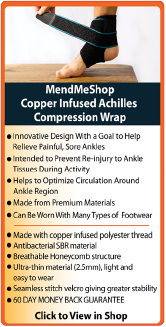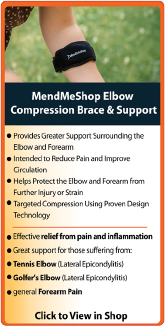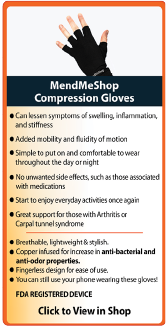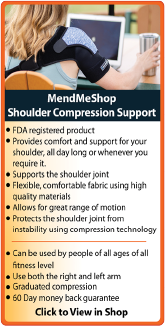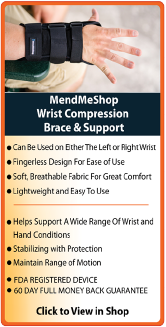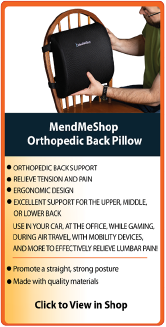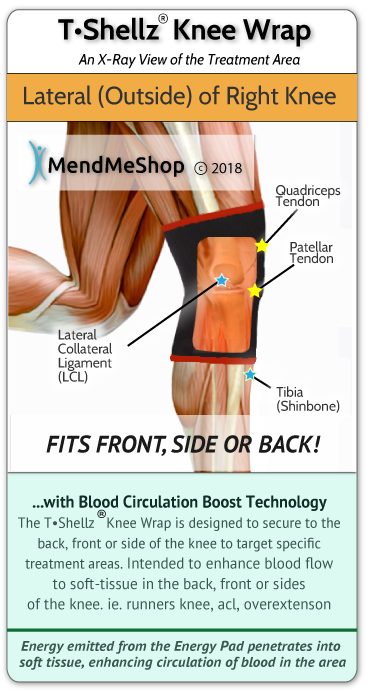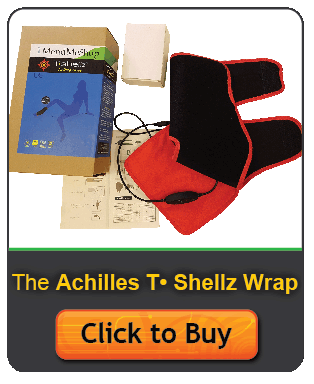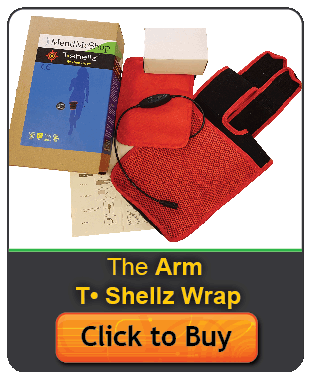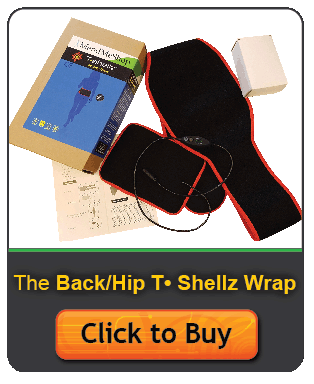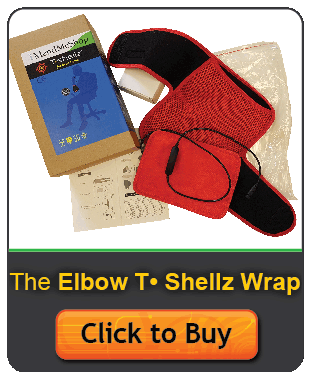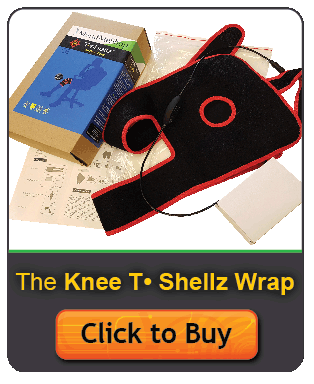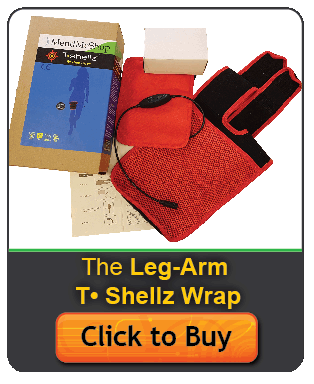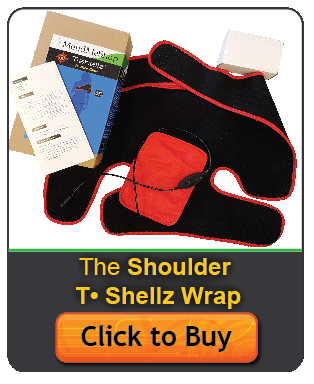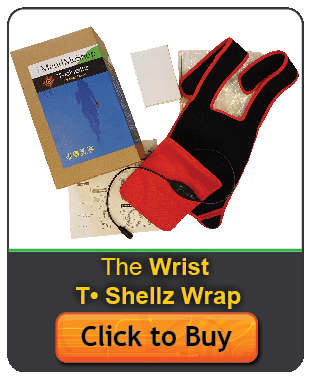|
| Ice vs Heat for Treating Your Meniscus InjuryWhat's Better to Treat a Meniscus Tear: Ice or Heat?Ice and heat are the best treatment combination for you if:
Combining cold and warmth is a simple yet effective way to get immediate pain relief and promote long-term healing. In your lifetime you've probably had your mom, family doctor, nurse, surgeon or PT tell you to use ice right after you're injured and something warm from time to time once the swelling's gone down. It's a simple yet very effective way to relieve pain and promote healing in your knee. If you want to be proactive about properly dealing with your meniscus tear, speak to your doctor about adding conservative temperature treatments to your home recovery with AidMyMeniscus's system using a Cold Compress or Ice Pack, MendMeShop Arnica Pain Cream, and Circulatory Boost with a Knee TShellz Wrap®. Conservative treatment tools are designed to help you achieve long-term healing results while aiding in the prevention of re-injury and/or secondary injuriesNote: If you have an Acute (recent, inflamed) Soft Tissue Injury, Do Not Use Heat.Your doctor knows that the sooner cold is applied, the quicker you can reduce inflammation and achieve real pain relief. This will help reduce the chance of a much longer lasting chronic injury. Heat and inflammation are a bad mix and should not be used together. Heat is good at the spa - it will help your body relax, but when it comes to an injury that is swollen, it is not a good idea. Which is Better for Treating Your Torn Meniscus: Ice or Heat?When it comes to using ice and heat for treating meniscus injuries, it's important to keep in mind that both ice AND heat are effective ways to relieve pain and heal. Most people will think one is better over the other from their own experience or what a doctor / physical therapist has previously told them. When dealing with the meniscus, it is important to keep in mind that the inner portions of the meniscus have very little to no blood flow whereas the outer portions have much more. The rate of healing via heat therapy for the meniscus will depend largely on where the meniscus injury is located. The only difference between using ice and heat is that one is better for you at a specific time in your healing cycle. Ice is used first, right when you get your injury, to decrease pain / swelling and inflammation. Once swelling has reduced, we then focus on heat based treatments to increase localized circulation to stimulate the body's healing response. Each temperature therapy has its own unique benefits for soft tissue injuries, and when used together they provide a powerful advantage to long-term healing. You may already know that ice or heat feels better on your injured meniscus, and this could influence your decision too. The bottom line is that ice and heat are exceptional, natural, pain relievers and healers for soft tissue injuries of the knee. There are cases where some meniscus injuries will respond better to one temperature over the other. We want to help clear up the confusion so you know which is better (icy cold or gentle heat) and how to get the most from your treatment at home. When To Use Cold On A Meniscus Injury:A Cold Compress or Ice Pack work best to relieve pain, swelling and inflammation for new injuries, re-injury and during immediate post surgery recovery. Cold therapy should also be used during the first 24 - 72 hours of treatment, combined with resting your injury. If you've been suffering for some time with a chronic meniscus injury you should only use cold after activity causes you more pain or triggers more inflammatory response symptoms (red, hot, inflamed, swollen). This would be when your knee starts to hurt at the end of the day after you've been on your feet, active in athletics, or performing any other tasks that has put a lot of weight or stress on your menisci. When used at this time cold compression becomes a natural / organic pain reliever, treating the site where you feel the pain. COLD (ice) is used to treat injuries or conditions that are red, hot, inflamed, swollen and suffering from tissue damage (a tear or recovering from surgery). Cold therapy is a natural / organic pain reliever that numbs pain right at the source of your injury. While doing this, the cold also stops tissue break-down and reduces the amount of scar tissue forming (this is very important after surgery).  When cold is applied to a meniscus injury, all of your soft tissue will squeeze on the veins to slow down your blood flow. This in turn clamps down on the amount of fluid leaking into your knee, decreasing your swelling. This is why cold is used immediately to treat newer meniscus injuries or re-injuries. The cold slows down your body to stop the amount of damage happening to your tissue and decrease your swelling. This cold also has a nice side benefit of numbing the nerves in and around your meniscus injury thereby decreasing your pain. In the medical world this is something called 'Vasoconstriction'. Sometimes we feel pain while doing a certain activity - should you still use cold? Too much cold therapy can reduce your ability to heal correctly, because cold is a short term pain reliever not a deep tissue healer. We put milk in the fridge so it will stay fresh longer. We do this so it will stay in the same condition as when we bought it. Your injury is no different. Too much cold will keep your injury in the same state - slowing down the healing process. This can sometimes make chronic injuries linger even longer. Heat (Circulation Boost) should be used when you suffer from a chronic, tight or stiff meniscus injury and after you reduce swelling, pain and inflammation with cold. Cold should be used:
Here are a couple of examples for when to use cold (ice):You have a meniscus tear injury that's been on-going for quite some time.Your knee is feeling quite good today, so you decide to walk the dog a few extra blocks for a longer route. You regret your decision afterwards because your knee is really throbbing now and is quite painful. Use COLD on your knee to arrest further damage to the knee, help reduce the inflammation and help ease the pain. Rest and continue using cold treatments until the pain and swelling are down. You occasionally feel sharp shooting pain in your knee with some popping, clicking, locking or buckling.You're not sure if you have an injury, but the pain seems to come and go only when you're on your feet for an extended period of time or walking, jogging, jumping or running. When you feel the sharp pain, the pain will continue to build up and afterwards your knee may feel weak or unstable. The popping, clicking, buckling & locking symptoms mean you should be visiting your doctor. The pain is temporary but if there is some inflammation, use a Cold Compress or Ice Pack on your knee, as it naturally relieves pain and inflammation. Once pain and swelling is non-existent, a heat treatment (via the Knee TShellz Wrap®) should be considered to encourage healing of the underlying injury. It would also be highly prudent to temporarily avoid the activities that make your knee pain worse until the injury has healed. Use cold after any sort of activity causes you on-going pain.Cold can Make Your Meniscus Injury Worse - How?Applying cold can restrict blood flow and stiffen / tighten soft tissue. Cold is NOT a good treatment method for your meniscus when the tissue is already tight and constricted, because the cold will just stiffen the tissue further. If you feel you have constricted or tight tissue, you should use a therapy that will increase blood flow instead - like Circulatory Boost (via the TShellz Wrap®). Increasing blood flow at this time will help to relieve any tightness or stiffness. Circulatory Boost used at this time will also help to relax / elongate your tissue making it much more pliable for activity. When Should You Use A TShellz Wrap (HEAT) to Increase Blood Flow to Your Meniscus?Heat temperature treatments work best to increase blood flow circulation and stimulate healing for soft tissue injuries, re-injuries, and during long-term post surgery recovery - once inflammation has been reduced. HEAT (warmth) is used after you've reduced your swelling / inflammation and the sharp pain is less intense (you have more of a dull / nagging ache and soft tissue tightness in your knee). Warming up your tissue is a natural way to stimulate the body's healing response. Increasing the temperature of tissue will result in increased blood flow circulation. It's the blood in your body that will bring oxygen, nutrients and water (basically energy) to your damaged meniscus to help with healing (where possible). It's no secret that meniscus tears don't receive enough natural blood flow, especially if the tear is located near the center of your knee joint - in which case there is very little chance to heal it other than through surgery. However, for meniscus tears near the outer edge, enhancing blood flow might turn the tide, and this is what makes boosting natural blood flow all the more important in such cases. Heat / warming temperature treatment works best to increase blood flow circulation for older (chronic) injuries, re-injury (after swelling has been reduced) and during long-term post surgery recovery. Warmer temperatures should be used approximately 3 to 5 days after you first have the injury or later if there is still significant swelling. Heat should not be started for a least 6 weeks after surgery and only then on express approval from your surgeon; inflammation levels will be very high as the healing process starts over again. When using a warming therapy, it is typically advised to combine this with gradual movement to stretch out your knee and increase range of motion. If you have a chronic meniscus tear that keeps getting re-injured you should use heat before activity to loosen up the soft tissue in your knee, making it more flexible.. When used at this time the warm temperatures naturally extend the elasticity (elastic-nature) of the soft tissue in your knee, making it more movable / pliable for activity. Sometimes we feel pain while doing a certain activity - should you still use heat? Using heat in the morning before you start your day or before activity can help to boost the healing process and reduce your risk of re-injury. Too much heat (especially when you suffer a set-back with swelling / inflammation) can make your inflammation worse. Cold compression with a Cold Compress or Ice Pack should be used part-way through your day when you suffer from on-going pain and inflammation as a natural pain-reliever. The application of heat via the TShellz Wrap® is a good long-term plan as you will find it to be a highly beneficial tool for soft tissue injuries - both in the recovery process as well as for long term re-injury prevention healing. It can also be used on a preventive basis to relax constricted soft tissue. Circulatory Boost enhances the local blood circulatory system, increasing the flow of nutrients your tissue needs to heal - oxygen, nutrients and water (basically energy). When heat is applied to your knee, your veins will start to get bigger (expand) to allow more blood flow through to your meniscus tear. This in turn relaxes your knee, making your meniscus more flexible and elastic. This is why heat is used on older (chronic) injuries, to loosen tissue and bring in the blood flow needed for healing. Your body will begin to heal itself after its' injured. Increasing your blood flow with heat will actually speed up this natural process. Doctors usually call this process 'Vasodilation'. Heat (via the Knee TShellz Wrap® is Typically Recommended for Use:
Heat can Make Inflammation, Swelling and Newer Injuries Worse - How?When we injure ourselves, we start healing right away. The body will naturally raise the temperature at the site of the injury resulting in the inflammatory response (redness, heat sensation, inflammation and swelling). This 'fake fever' leaks blood flow to the area to cool it down and start the healing process. Adding 'heat' to your injured meniscal tissue when it's already inflamed and tender may make your body think there's a new threat to your tissue and increase the pain in order to get you to stop. For some people applying heat on inflamed / swollen tissue will cause the injury to swell-up even more (as much as 3 times larger than normal). You'll feel even more pain as the pressure builds in your knee. Heat is NOT a good treatment method for inflamed soft tissue injuries, new injuries (within the first 24 to 72 hours), right after surgery or right after a re-injury (over-use and/or sharp, throbbing pain). In these cases, heat should be applied later on in the healing cycle. In the meantime, a Cold Compress or Ice Pack should be used to decrease any inflammation induced pain. Here are a couple of examples for when to use a TShellz Wrap®:You had meniscus tear 2 years ago but that injury has healed and you no longer feel pain everyday.You just went to a new fitness / aerobics class and notice your knee feels stiff the day after your first class. There's no pain, inflammation or swelling, just stiffness / soreness where your old injury was. You should use HEAT (Circulation Boost) on your knee before you work out to loosen up your soft tissue. Heat can be used again the next day if you notice any residual stiffness. If the stiffness remains, you should continue to use heat to make sure your old meniscus injury doesn't get worse. You suffered from a meniscus tear about 18 months ago and just felt a twinge in the area while trying to bring your vacuum cleaner up a set of stairs in your house.You haven't experienced any pain from the old injury but you realize it's still there when you try to carry the vacuum up the stairs. Flexing and putting weight on your knee just reminded you of the old injury, and now you feel a dull ache in your knee. You stop and ask someone else to bring the vacuum upstairs for you (you stopped the activity that will cause more tearing in your meniscus). The pain levels are low but there is no swelling which means NO cold compression is needed. In this case heat (Circulation Boost) should be used to relieve the dull ache in your knee and encourage healing of your damaged tissue. Keep using a Knee TShellz Wrap® before activity and when you notice any stiffness in your knee to 'warm up' your tissue and stimulate blood flow to the area.With regular use of the TShellz Wrap:
Our high quality wraps are registered with the FDA as medical devices which meet high manufacturing standards. How to Use Consistent Deep Tissue Stretching for Improved Knee Flexibility & Health For most people, an essential part of rehabilitation comes down to stretching - this is why physical therapy is such an important component for recovery. Stretching is also an important part of recovery from a meniscus tear - and it's the final step needed when healing your knee injury via conservative treatment methods. You would be surprised by how many people there are that don't understand the importance of stretching their knee joint during the latter stages of recovery from a meniscus tear. Before returning to full activity after an injury, physical therapists prescribe gentle stretching... This is because stretching is a major component when it comes to healing soft tissue. Consistent stretching is one of the only solutions available to break up scar tissue that forms around your meniscus as it heals. Stretching soft tissue after a recent treatment with the TShellz Wrap is the best way to gain the stretching you need for recovery while minimizing the risk of re-injury. This is due to the heat effect on soft tissue - it elongates and increases flexibility of soft tissue which is exactly what you want when you are stretching.There is a Unique Formula used for Meniscus Injury Recovery...We're going to let you in on a key piece of information... In a typical physical therapy appointment your physical therapist will use conservative treatments, massage, manual manipulation and/or stretching exercises general guided via a Professional 3-Step Treatment Formula: Step 1 - Warm Up Your Meniscus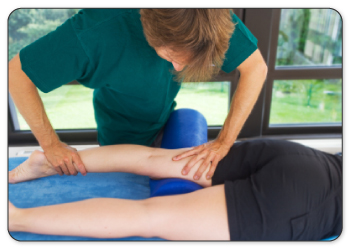 For this 1st step many physical therapists will use heat, manual manipulation, deep tissue massage, clinical ultrasound devices or a warm bath to warm up your injury site. The goal during this first step is to increase healthy blood flow circulation and relax your affected tissue. 'Warming up' your injury will increase the elastic-nature of your tissue fibers making it much easier to stretch and when needed, hold the stretch. This will also extend the amount that you will be able to stretch your injury site. Warm it Up At HomeUse a Knee TShellz Wrap® for 15 to 20 minutes at least half an hour before stretching your knee. A TShellz Wrap® will promote Circulation Boost (Circulatory Boost) - a therapy that will increase the blood flow to your meniscus while warming up and relaxing your injured tissue. Circulatory Boost will make your soft tissue fibers more elastic and pliable, allowing for more ease of movement while you are stretching and/or exercising. Continued treatment with Circulatory Boost will also deliver much-needed oxygen, nutrients and water (basically energy) to your knee. This will boost your own natural healing ability and shorten your overall recovery time. Step 2 - Stretch Your Knee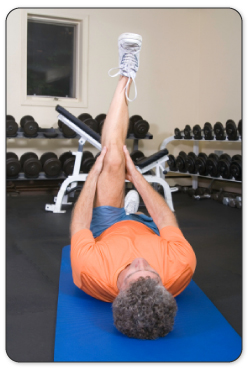 The main goal of physical therapy is to exercise (stretch out) your meniscus to improve flexibility and range of motion. After the physical therapist has warmed up your soft tissue, they'll get you to do a series of exercises that are focused on stretching the area and surrounding soft tissue. This exercise may include heel slides that are focused on moving your knee, meniscus, quadriceps, groin, hip, hamstring, calf, shin and Achilles tendon. Sometimes cardiovascular exercise, like using a stationary bike or treadmill, will be recommended under the supervision of your physical therapist. Step 3 - Cool Down Your KneeToward the end of your appointment your physical therapist may introduce cold compression, acupuncture, or TENS to relax your knee after the intense stretching and exercise. Use a Cold Compress or Ice Pack after stretches or exercise - or whenever you feel swelling and pain. The Cold Compress or Ice Pack will help prevent full-blown inflammation from returning after your stretching routine. Why Are Knee Injuries So Hard To Overcome? In Two Words - Scar Tissue Soft tissue is meant to be soft and flexible, ready to work and move extreme forces in everyday activities. A meniscus tear will heal with scar tissue; little tiny band-aids that overlap each other on the tissue mending the injury. With the added scar tissue your meniscus becomes rigid, less ready to move and unable to receive the full force of your movements. If you're suffering with scar tissue now you may feel the effects with stiffness, tightness, weakness and tiredness in your knee. Scar tissue can form fast to bring together the edges of a meniscus tear, but working fast doesn't mean that the job's done right. When scar tissue forms it doesn't come together as neatly as regular (healthy) tissue would. Scar tissue fibers will lay down over top of your tear in a cluttered, messy and jumbled up way. Imagine throwing a bunch of drinking straws in the air... When those straws hit the ground they'll land in a random, unorganized way. It even seems silly to think that those straws could land perfectly straight and all in the same direction. Stretching helps to organize the scar tissue, increasing the strength of this tissue so it's more like the weave of a basket. Our Knee Therapy Formula is |
 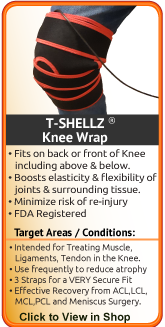  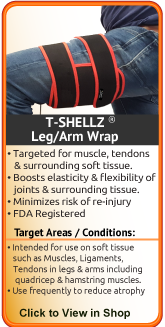    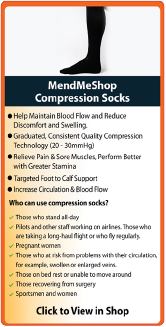 |

